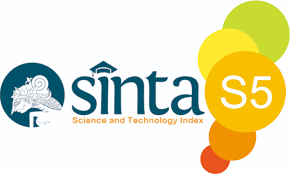PENERAPAN METODE K-MEANS CLUSTERING DALAM KLASTERISASI PEMINATAN SISWA TERHADAP MATA PELAJARAN SIMULASI DIGITAL (SIMDIG)
Abstract
Abstract : SMK Negeri 2 Bengkulu City is one of the State Vocational High Schools that located in Bengkulu City. Digital Simulation subjects (Simdig) are taught to class X students at school. The ability of students to understand these subjects is different, so it is sometimes difficult for the teacher during the learning process. Interest in learning tends to produce high achievement, otherwise a lack of interest in learning will result in low achievement. This is what causes the interests of each student to be different from other students. The implementation for clustering students' interest in Digital Simulation (SimDig) subjects at SMK Negeri 2 Bengkulu City is used to assist teachers in evaluating the teaching and learning process that has been carried out based on the grades that have been obtained by students at the end of the semester. The attributes used as parameters in determining the student's specialization are attendance scores, assignment scores, UTS scores, and UAS scores per semester per academic year. Based on the data on student scores in the SimDig subject as many as 24 students, the results of the clustering of students' specialization were 62.5% (Highly Interested) and 37.5% (Less Interested). Based on the results of the tests that have been carried out, the functionalities of the application for clustering students' interest in Digital Simulation subjects (SimDig) at SMK Negeri 2 Bengkulu City are running well as expected, and can provide information on the results of clustering of students' specialization in Digital Simulation subjects.
Downloads
Copyright (c) 2023 I Putu Yogi Saputra; Siswanto Siswanto, Jhoanne Fredricka

This work is licensed under a Creative Commons Attribution-ShareAlike 4.0 International License.
An author who publishes in Jurnal Media Infotama agrees to the following terms:The author holds the copyright and grants the journal the right of first publication of the work simultaneously licensed under the Creative Commons Attribution-Share Alike 4.0 License which allows others to share the work with acknowledgment of the work's authorship and initial publication in this journal.Submission of a manuscript implies that the submitted work has not been previously published (except as part of a thesis or report, or abstract); that it is not being considered for publication elsewhere; that its publication has been approved by all co-authors. If and when a manuscript is accepted for publication, the author retains the copyright and retains the publishing rights without limitation.
For new inventions, authors are advised to administer the patent before publication. The license type is CC-BY-SA 4.0.
MEDIA INFORMATION REVIEW: Journal of the Faculty of Computer Science is licensed under a Creative Commons Attribution-ShareAlike 4.0 International License.You are free to:Share
— copy and redistribute material in any medium or formatAdapt
— remix, modify and develop materialfor any purpose, even commercial.
The licensor cannot revoke this freedom as long as you follow the license terms












.png)


